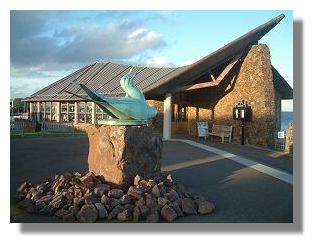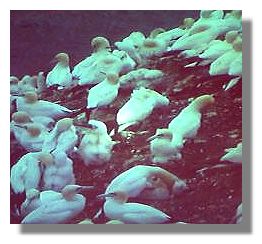
Places to Visit in Scotland
- Scottish Seabird Centre, North Berwick

An Idea Takes Off
It's always great to hear about someone bringing a brilliant idea to a successful conclusion. North Berwick was once a popular seaside resort but as times and tastes change and package holidays to the Mediterranean took off, it began to decline, like many similar locations. The open-air swimming pool on the seafront in particular was under-utilised and expensive to maintain. Then local businessman Bill Gardner, a keen ornithologist, realised that on North Berwick's doorstep was a unique visitor attraction - the Bass Rock, less than three miles offshore and is over home to over 120,000 seabirds during the breeding season. And with improving video camera technology it became possible for thousands of visitors to get up close to the birds without disturbing them.
It took nearly ten years, however, to put all the pieces of the jigsaw for the Scottish Seabird Centre together. A charitable trust was formed and on the site of the former swimming pool a visitor centre was built, its roof shaped like a gull's wing. And unlike the swimming pool, this is a facility that can cater for visitors throughout the year.
Having set up the Seabird Centre, Bill Gardner is now working on a new project - a Scottish Ornithology Centre at an inland location, which will focus on the many wild birds found in that part of Scotland.
Bass Rock
Formed from the remains of a volcano 320 million years ago, the solidified lava of the Bass Rock now rises 350 feet from the sea. Roughly a mile in circumference, every part of it - the cliffs as well as the upper area - provides a home for nesting seabirds. Gannets, in particular, have thrived in recent years, their numbers rising from around 25,000 in the 1960s to over 120,000 today, making it the largest single-rock gannetry in the world. Most leave in the late autumn to fly to West Africa to recover from the exertions of rearing their family. They return the following spring - to exactly the same nesting position on the rock.
By the time all the gannets have taken up residence again, the Bass Rock looks from a distance as though it is covered in snow - but that's just the closely packed gannets. Even so, the fiercely competitive birds are carefully spaced outwith of pecking range of other brooding birds. Once the chicks have hatched, the parents will fly all over the North Sea as far as Norway to catch fish to bring back to feed the young ones. Gannets have spectacular method of diving into the sea from a height when they spot shoals of fish, reaching speeds of 100mph. The photo here is of a young gannet that has yet to develop its adult plumage.When the young gannets are ready to breed, they return from Africa, back to the Bass rock where they were born. If they take a site of an older pair who arrive later, there is then a noisy battle!
Interactive Video Cameras

While some hardy folk take a sea-trip to get a closer look at the Bass Rock, they are unlikely to get as good a close-up view as that provided by the video cameras that have been installed. There are large display screens in the Scottish Seabird Centre and one of the great benefits is that the cameras can be controlled by visitors to the centre. The controls allow the camera to pan, tilt up and down and zoom in and out. And the screens are big enough to allow everyone else to see the picture even if they don't have the controls. There are cameras covering not just the Bass Rock but also the other nearby islands of Fidra and the Isle of May.You may think that once the majority of the seabirds have gone, there would not be much to see. But by late autumn thousands of grey seals have landed on the Isle of May. The seal colony there is the largest on the east coast of Scotland. The cameras on the cliffs of Pilgrim's Haven on the island provide a close-up view of the seals and their fluffy, white pups - or the adult males snarling and fighting!
Lots of Facilities
Telescopes on the viewing deck provide distant views of the Bass Rock with the seabirds circling and dicing and the puffins on nearby Craigleith Island. It would be nice to think that you could get as close up as this picture (of a guillemot) but they are far too far away. Instead, there is a full-scale representation of a cliff in the Seabird Centre with stuffed birds in realistic poses.
The centre also has a cinema showing (of course) films on seabirds and other marine life and the well-equipped shop has the usual tourist trinkets but also a good selection of books and videos. And although it can get very crowded at peak times, there is a restaurant providing a surprisingly wide range of made-to-order food.
Since there is always something worth seeing, the Scottish Seabird Centre is open all-year-round, except Christmas Day. See the Scottish Seabird Centre Web site for details.
How to Get There
North Berwick is about 20 miles east of Edinburgh. Follow the A1 from Edinburgh and at Tranent you have a choice of the slower B1348 road and then the A198 through the coastal villages, passing by Dirleton Castle on the way to North Berwick. Or take the faster dual-carriageway, past Haddington and then left onto the A198 after East Linton and the Preston Mill and Phantasie Doocot to North Berwick (passing Tantallon Castle on the way). The Scottish Seabird Centre is obviously on the sea-front. The "official" sign-posted car park is some distance away. In the busy summer season this car park may be advisable but at quieter times it is possible to park on Melbourne Road, beside the beach.See also the Location Map (you can enlarge the scale of this map, if required).
Return to Index of Places to Visit
Where else would you like to go in Scotland?

